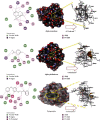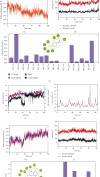GC-MS Profile, Antioxidant Activity, and In Silico Study of the Essential Oil from Schinus molle L. Leaves in the Presence of Mosquito Juvenile Hormone-Binding Protein (mJHBP) from Aedes aegypti
- PMID: 35615009
- PMCID: PMC9126701
- DOI: 10.1155/2022/5601531
GC-MS Profile, Antioxidant Activity, and In Silico Study of the Essential Oil from Schinus molle L. Leaves in the Presence of Mosquito Juvenile Hormone-Binding Protein (mJHBP) from Aedes aegypti
Abstract
Schinus molle is a medicinal plant used as an anti-inflammatory and for rheumatic pain in the traditional medicine of Peru. On the other hand, Aedes aegypti is the main vector of several tropical diseases and the transmitter of yellow fever, chikungunya, malaria, dengue, and Zika virus. In this study, the aim was to investigate the antioxidant activity in vitro and the insecticidal activity in silico, in the presence of the mosquito juvenile hormone-binding protein (mJHBP) from Aedes aegypti, of the essential oil from S. molle leaves. The volatile phytochemicals were analyzed by gas chromatography-mass spectrometry (GC-MS), and the profile antioxidants were examined by DPPH, ABTS, and FRAP assays. The evaluation in silico was carried out on mJHBP (PDB: 5V13) with an insecticidal approach. The results revealed that EO presented as the main volatile components to alpha-phellandrene (32.68%), D-limonene (12.59%), and beta-phellandrene (12.24%). The antioxidant activity showed values for DPPH = 11.42 ± 0.08 μmol ET/g, ABTS = 134.88 ± 4.37 μmol ET/g, and FRAP = 65.16 ± 1.46 μmol ET/g. Regarding the insecticidal approach in silico, alpha-muurolene and gamma-cadinene had the best biding energy on mJHBP (ΔG = -9.7 kcal/mol), followed by beta-cadinene (ΔG = -9.5 kcal/mol). Additionally, the volatile components did not reveal antioxidant activity, and its potential insecticidal effect would be acting on mJHBP from A. aegypti.
Copyright © 2022 Oscar Herrera-Calderon et al.
Conflict of interest statement
The authors declare no conflicts of interest.
Figures



Similar articles
-
Chemical composition and anticancer and antioxidant activities of Schinus molle L. and Schinus terebinthifolius Raddi berries essential oils.J Food Sci. 2010 Aug 1;75(6):C466-72. doi: 10.1111/j.1750-3841.2010.01711.x. J Food Sci. 2010. PMID: 20722898
-
δ-Cadinene, Calarene and .δ-4-Carene from Kadsura heteroclita Essential Oil as Novel Larvicides Against Malaria, Dengue and Filariasis Mosquitoes.Comb Chem High Throughput Screen. 2016;19(7):565-71. doi: 10.2174/1386207319666160506123520. Comb Chem High Throughput Screen. 2016. PMID: 27151483
-
Antioxidant, antimicrobial and toxicological properties of Schinus molle L. essential oils.J Ethnopharmacol. 2014;151(1):485-92. doi: 10.1016/j.jep.2013.10.063. Epub 2013 Nov 11. J Ethnopharmacol. 2014. PMID: 24231069
-
Essential oils and their chemical constituents against Aedes aegypti L. (Diptera: Culicidae) larvae.Acta Trop. 2020 Dec;212:105705. doi: 10.1016/j.actatropica.2020.105705. Epub 2020 Sep 19. Acta Trop. 2020. PMID: 32956639 Review.
-
The genus Schinus (Anacardiaceae): a review on phytochemicals and biological aspects.Nat Prod Res. 2022 Sep;36(18):4839-4857. doi: 10.1080/14786419.2021.2012772. Epub 2021 Dec 9. Nat Prod Res. 2022. PMID: 34886735 Review.
Cited by
-
Influence of the Extraction Method on the Biological Potential of Solidago virgaurea L. Essential Oil and Hydrolates.Plants (Basel). 2024 Aug 7;13(16):2187. doi: 10.3390/plants13162187. Plants (Basel). 2024. PMID: 39204623 Free PMC article.
-
Insight into Romanian Wild-Grown Heracleum sphondylium: Development of a New Phytocarrier Based on Silver Nanoparticles with Antioxidant, Antimicrobial and Cytotoxicity Potential.Antibiotics (Basel). 2024 Sep 23;13(9):911. doi: 10.3390/antibiotics13090911. Antibiotics (Basel). 2024. PMID: 39335084 Free PMC article.
-
Volatile Components, Antioxidant and Phytotoxic Activity of the Essential Oil of Piper acutifolium Ruiz & Pav. from Peru.Molecules. 2023 Apr 10;28(8):3348. doi: 10.3390/molecules28083348. Molecules. 2023. PMID: 37110583 Free PMC article.
References
-
- Ali B., Al-Wabel N. A., Shams S., Ahamad A., Khan S. A., Anwar F. Essential oils used in aromatherapy: a systemic review. Asian Pacific Journal of Tropical Biomedicine . 2015;5(8):601–611. doi: 10.1016/j.apjtb.2015.05.007. - DOI
-
- León-Méndez G., Pájaro-Castro N., Pájaro-Castro E., et al. Essential oils as a source of bioactive molecules. Revista Colombiana de Ciencias Químico - Farmacéuticas . 2019;48(1):80–93. doi: 10.15446/rcciquifa.v48n1.80067. - DOI
MeSH terms
Substances
LinkOut - more resources
Full Text Sources
Miscellaneous

